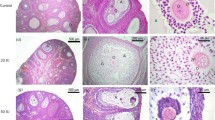Summary
A direct comparative study of the distribution of intact and Fab1 2 fragments of mouse monoclonal anti-human chorionic gonadotrophin antibody, W14A, in nude mice bearing a human choriocarcinoma xenograft, indicates that the tumour:blood ratio is generally improved with fragments. Some parameters which may determine the distribution are outlined.
Similar content being viewed by others
References
Arend WP, Teller DC, Mannik M (1972) Molecular composition and sedimentation characteristics of soluble ag — ab complexes. Biochemistry 11:4063
Begent RHJ, Bagshawe KD (1985) Clinical applications of radioimmunolocalisation. In: Baldwin RW (ed) Monoclonal antibodies for tumour detection and drug targeting. Academic Press, London (in press)
Brennan FM, Grace SA, Elson CJ (1983) Preparation of covalent IgG complexes of defined size and their clearance from the circulation of mice. J Immunol Meth 56:149
Buchegger F, Haskell CM, Schreyer M, Scazziga BR, Randir S, Carrel S, Mach J-P (1983) Radiolabelled fragments of monoclonal antibodies against carcinoembryonic antigen for localisation of human colon carcinoma grafted into nude mice. J Exp Med 158:413
Burchiel SW, Burke D, Breslow K, Austin R, Reed K, Rhodes B (1982) Biodistribution of radiolabelled antibodies and their fragments: an immunopharmacologic approach to in vivo tumour imaging. Proc West Pharmacol Soc 25:405
Cavalieri RR, Rapaport B (1977) Impaired peripheral conversion of thyroxine to triiodothyronine. Ann Rev Med 28:57
Colcher D, Zalutsky M, Kaplan W, Kufe D, Austin F, Schlom J (1983) Radioimmunolocalisation of human mammary tumours in athymic mice by a monoclonal antibody. Cancer Res 43:736
Ellman GL (1959) Tissue sulfhydryl groups. Arch Biochem Biophys 82:70
Folkers K, Shin S, Kappel M (1983) Structurally restricted conjugates of the subunit of human chorionic gonadotrophin to produce antisera. Biochem Inter 7,6:761
Herlyn D, Powe J, Alavi A, Mattis JA, Herlyn M, Ernst C, Vaum R, Koprowski H (1983) Radioimmunodetection of human tumour xenografts by monoclonal antibodies. Cancer Res 43:2731
Johnson PM, Brown PM (1981) Review Article: Fc receptors in the human placenta. Placenta 2:355
Mannik M, Arend WP, Hall AP, Gilliland BC (1971) Studies on antigen-ab complexes: elimination of soluble complexes from rabbit circulation. J Exp Med 133:713
Morgan FJ, Canfield RE (1971) Nature of the subunits of human chorionic gonadotrophin. Endocrinology 88:1045
Morgan FJ, Birken S, Canfield RE (1975) The amino acid sequence of human chorionic gonadotrophin. J Biol Chem 250:5247
Mason AW, Williams AF (1980) The kinetics of antibody binding to membrane antigens in solution and at the cell surface. Biochem J 187:1
Nisonoff A, Hopper JE, Spring SB (1975) The antibody molecule. Academic Press, New York, p 235
Nisonoff A, Hopper JE, Spring SB (eds) (1975) The Antibody Molecule. Academic Press, New York p 325
Ogston AG, Preston BN, Wells JD (1973) The transport of compact particles through solutions of chain-polymers. Proc Soc Lond A 333:297
Poste G (1983) Liposome targeting in vivo: problems and opportunities. Biol Cell 47:19
Quinones J, Mizejewski G, Beierwaltes WH (1971) Choriocarcinoma scanning using radiolabelled antibody to chorionic gonadotrophin. J Nucl Med 12,2:69
Scherphof G (1980) In Gregoriades G, Allison AC (eds), Liposomes in biological systems. John Wiley & Co, New York, p 179
Searle F, Boden J, Lewis JCM, Bagshawe KD (1981) A human choriocarcinoma xenograft in nude mice; a model for the study of antibody localisation. Br J Cancer 44:137
Searle F, Partridge CS, Kardana A, Green AJ, Buckley RG, Begent RHJ, Rawlins GA (1984) Preparation and properties of a mouse monoclonal antibody (W14A) to human chorionic gonadotrophin. Int J Cancer 33:429
Sedlacek HH, Gronski P, Hofstaetter T, Kanzy EJ, Schorlemmer HU, Seiter FR (1983) The biological properties of immunoglobulin G and its split products [F(ab1)2 and Fab]. Klin Wochenschr 61:723
Silverstein SC, Steinman RM, Cohn ZA (1977) Endocytosis. Ann Rev Biochem 46:669
Tomlinson E, McVie JG (1983) New directions in cancer chemotherapy 2. Targeting with microspheres. Pharmacy Inter 281
Towbin H, Staehelin T, Gordon J (1979) Electrophoretic transfer of proteins from polyacrylamide gels to nitrocellulose sheets: Procedure and some applications. Proc Natl Acad Sci USA 76:4350
Turner MW (1981) In: Glynn LE, Steward MW (eds) Structure and function of antibodies J Wiley & Sons, New York, p 38
Vaupel P, Muller-Kleiser W (1983) Interstitieller Raum und Mikromilieu in malignen tumoren. Mikrozirk Forsch Klin 20:78
Wataya Y, Santi DV (1975) Thymidylate synthetase catalysed dehalogenation of 5-bromo and 5-iodo-21-deoxyuridylate. Biochem Biophys Res Commun 67:818
Widder KJ, Senyei AE, Sears B (1982) Experimental methods in cancer therapeutics. J Pharm Sci 71:379
Author information
Authors and Affiliations
Rights and permissions
About this article
Cite this article
Searle, F., Adam, T. & Boden, J.A. Distribution of intact and Fab1 2 fragments of anti-human chorionic gonadotrophin antibodies in nude mice bearing human choriocarcinoma xenografts. Cancer Immunol Immunother 21, 205–208 (1986). https://doi.org/10.1007/BF00199363
Received:
Accepted:
Issue Date:
DOI: https://doi.org/10.1007/BF00199363




